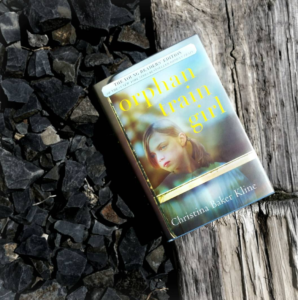- What were the orphan trains?

- What sort of research did you do for the book, and did you interview people who were connected to the Train? What was that like?
- How long did this book take to research and write?
- What was the most surprising detail you discovered in your research?
- How many children have gone through orphan trains?
- What were the demographics of nationalities of all the children throughout the 75-year span?
- How close are the events you describe in the novel to real life? Did you exaggerate/make things up? How important was it for you to stick to the facts?
- What are the biggest challenges in USA today?
- What were orphan trains?
Two hundred and fifty thousand poor, orphaned, and abandoned city children were sent on trains to the Midwest from the East Coast between 1854 and 1929. A Methodist minister, Charles Loring Brace, conceived of this as a way to get underage criminals and vagrants off the crowded streets of New York, and provide free labor (along with a strong dose of Christian values) to poor farmers in the sparsely populated heartland.
That strongly reflected the social situation in USA of that time, Depression. How was it to live in USA then? You’ve done some research. There were no social programs of any kind in the USA when the trains started running: no welfare, no foster care, no child welfare laws, no child labor laws. Children were property – they had no rights – and poor children were labor.
- What sort of research did you do for the book, and did you interview people who were connected to the Train? What was that like?
After finding articles online from the New York Times and other newspapers, I read hundreds of first-person testimonials from train riders, orphan-train reunion groups, and historical archives. That research led me to The New York Public Library, where I found a trove of original contemporaneous materials. I devoured nonfiction histories, children’s novels and picture books, and conducted research at the New York Tenement Museum and Ellis Island. I also traveled to Galway County in Ireland to research my character’s Irish background. In the course of writing this book I attended train riders’ reunions in New York and Minnesota and interviewed train riders and their descendants. There aren’t many train riders left; those who remain are all over 90 years old. I was stuck by how eager they were to tell their stories, to each other and to me. In talking to them and reading their oral histories, I found that they tended not to dwell on the considerable hardships they’d faced; instead, they focused on how grateful they were for their children and grandchildren and communities – for lives that wouldn’t have been possible if they hadn’t been on those trains.
I realized that in fiction I could do something that is difficult to do in real life: I could dwell on the stark details of the experience without needing to create a narrative of redemption.
- How long did this book take to research and write?
I stumbled on to the story of the orphan trains a decade ago. I was stunned to learn that more than 200,000 abandoned, neglected, or orphaned children had been sent from the East Coast to the Midwest on trains between 1854 and 1929. The idea of writing about this little-known part of American history percolated for years. About three years ago, I found the key: an appealingly irascible 17-year-old with nothing to lose who pries the story out of a 91-year-old with a hidden past as a train rider. I read more than 300 first-person accounts and dozens of books, attended train-rider reunions, and talked with half a dozen train riders (all between the ages of 90 and 100), and conducted research in Ireland, Minnesota, Maine, and [New York City’s] Lower East Side.
The writing took about two years — but I did several years of research before that. I attended four orphan-train reunions (in New York and Minnesota), interviewed seven living train riders, read hundreds of train riders’ stories, and went to Galway County, Ireland.
I dove into the research for several months, but eventually I had to start writing. I continued to research at every step of the way. This book is based on real events. It was quite a surprise.
- What was the most surprising detail you discovered in your research?
The most surprising thing, honestly, is that so few Americans know about the orphan trains. Two hundred thousand people is a pretty large migration! I was also surprised at the resilience and fortitude of the train riders I met, their pragmatism and grace. I don’t know whether this is a midwestern trait or simply a human one. Also surprising was that for decades, many train riders believed that the train they rode on was the only one. They didn’t know that they were part of a massive 75-year social experiment. It wasn’t until their own children and grandchildren got involved and started asking questions –there are more than two million descendants, according to some estimates – that they met other train riders and began sharing their stories.
- How many people have gone through the orphan trains?
About 250,000 children, between 1854 and 1929. Record-keeping was spotty, and we don’t have exact numbers.
- What were the demographics of nationalities of all the children throughout the 75-year span?
Record keeping was so spotty that there’s no exact data, but essentially the orphan trains took poor children from the streets of East Coast cities. Most new immigrant groups were represented.
- How close are the events you describe in the novel to real life? Did you exaggerate/make things up? How important was it for you to stick to the facts?
Almost everything that happened in Orphan Train actually happened to someone in real life (including, for example, the story of the boy who was traded by a farmer for a pig). Many train riders ended up with their names changed more than once, and many went into multiple homes. I didn’t have to exaggerate; each real-life train rider story I heard or read was filled with drama, heartache, coincidence, and surprise. Some stories I heard were much more dramatic, in fact, than the one I told, but I didn’t want to stretch credibility. It was important to me that a train rider or a descendant could read this novel and know that I told an accurate story. I fact-checked every aspect of the book, from the Children’s Aid Society to the draft in World War II. So far, the only factual error anyone has pointed out is that apparently there is no such thing as a pink crocus. A botanist in the audience one evening raised her hand and announced it!
- What are the biggest challenges in USA today?
Is there a new kind of Depression going on or things are better? There is not a new Depression. Things are better. As Martin Luther King said, , ‘The arc of the moral universe is long, but it bends towards justice.’ Child welfare is still a problem in the USA, as it is in every country on earth. But today, at least, we have laws and regulations intended to protect poor children.
